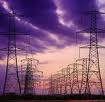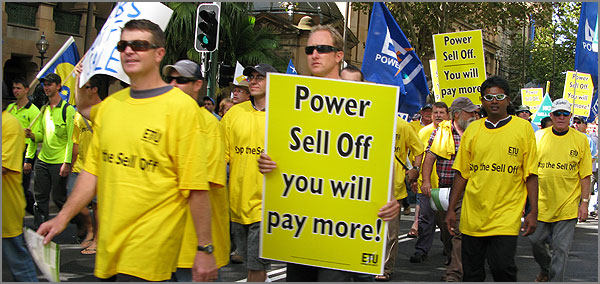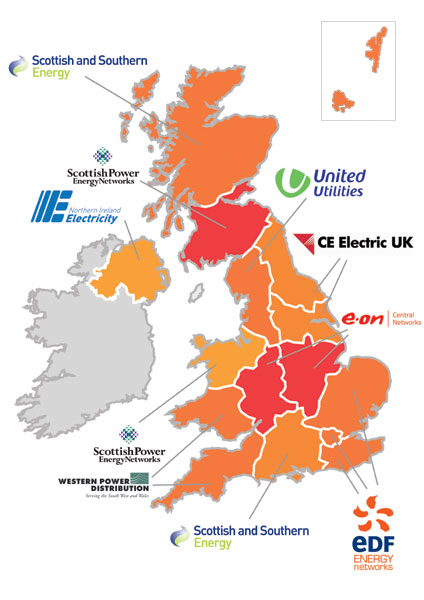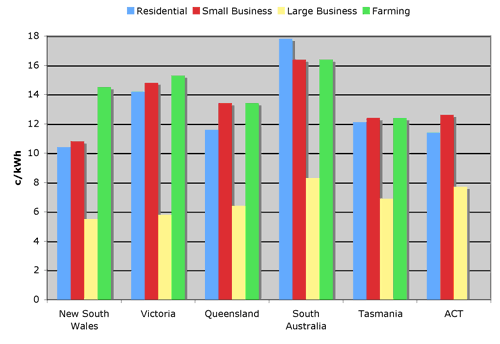In most countries around the world where electricity has been privatised or deregulated, retail electricity prices have increased, often dramatically for households and small businesses. Where wholesale prices declined, it was usually as a result of external cost reductions, particularly in the cost of fuel, as in the UK, and had the government-owned system remained in place consumers/taxpayers would have reaped the benefits. But in an unregulated private system, savings have been largely retained by the private electricity companies along the electricity supply chain.
 However, electricity generating companies around the world have made big profits. A World Bank study of 61 privatised electricity enterprises in 18 countries found that profitability rose an average of 45 percent. However this profitability of privatised companies has been achieved through price gouging rather than through the managerial expertise and increased efficiency of operations under private ownership.
However, electricity generating companies around the world have made big profits. A World Bank study of 61 privatised electricity enterprises in 18 countries found that profitability rose an average of 45 percent. However this profitability of privatised companies has been achieved through price gouging rather than through the managerial expertise and increased efficiency of operations under private ownership.
 In a 2009 paper, John A. Anderson, president of the Electricity Consumers Resource Council (ELCON) in the US found that efforts to foster competitive markets in electricity, whether through privatisation in Europe and Australia, or deregulation in the US, have “not provided the sought after consumer benefits”. In a review of the UK, Spain, Germany, France, the European Union, Australia and the US he found the result had been higher electricity prices — not explained by rising fuel costs, unhappy electricity consumers and significant market power — particularly in the hands of electricity generators. He found that the promised technological innovation had not eventuated and that auction-based electricity markets made it easy for generators to manipulate prices — so that bids did not reflect costs — and created a disincentive to invest in new resources and infrastructure.
In a 2009 paper, John A. Anderson, president of the Electricity Consumers Resource Council (ELCON) in the US found that efforts to foster competitive markets in electricity, whether through privatisation in Europe and Australia, or deregulation in the US, have “not provided the sought after consumer benefits”. In a review of the UK, Spain, Germany, France, the European Union, Australia and the US he found the result had been higher electricity prices — not explained by rising fuel costs, unhappy electricity consumers and significant market power — particularly in the hands of electricity generators. He found that the promised technological innovation had not eventuated and that auction-based electricity markets made it easy for generators to manipulate prices — so that bids did not reflect costs — and created a disincentive to invest in new resources and infrastructure.
The supposed disciplines of the market have been eclipsed by price manipulation by private electricity companies seeking to boost the price of electricity and maximise profits. Price volatility and manipulation are an inevitable function of electricity markets, whatever their design. In a market, there is no central planner choosing which plants to call on according to logic and marginal costs. Instead “the central planner is replaced by price signals”. Price fluctuation is exacerbated by the ease with which private companies can use their market power, or create artificial shortages of electricity, to force the price up to very high levels, even in times of lower demand. Electricity markets bring a disjuncture between price and the cost of production.
In places where government imposed price caps are in place, retail suppliers have not been able to pass these high wholesale prices on to consumers causing them to experience financial difficulties that have led to black outs and government bail outs, as in California.
 In the Dominican Republic, privatisation of electricity led to huge price increases and frequent and lengthy blackouts.
In the Dominican Republic, privatisation of electricity led to huge price increases and frequent and lengthy blackouts.
In Brazil, Light Serviços de Electricidade (Light) was auctioned in 1996 and purchased by a consortium comprised of EdF of France, AES of the US and CSN of Brazil. The terms of the contract meant that Light would buy hydroelectric electricity from the state at USD 23 per MWh and sell it to consumers for USD 120, compared with USD 75 that EdF charged the more affluent French electricity consumers. Consumers experienced massive price rises while the foreign owners repatriated profits and avoided investing in new generating capacity (McKee, 1996; Benjamin, 2001; Costa, 2001).
Enron used its political influence with US embassies and the CIA to win a $3 billion contract to build the Dhabol Power Plant south of Bombay, India, in 1992. This was the largest foreign investment in India. Enron charged so much for electricity that the state government ended its agreement to buy the electricity in June 2001 and the plant was forced to shut down.
Even World Bank analysts admit that Independent Power Producers (IPPs) like Enron have often inflated supply prices for utilities around the world. In the Philippines, for example, the price of power from the IPPs, even before the Asian crisis in 1996, was US$76 per MWh compared with US$57 for state-owned Napocor’s power (Albouy and Bousba, 1998). Electricity prices for consumers in the Philippines became the highest in the ASEAN Region.
 Britain, which was one of the first nations to privatise electricity, is supposed to be the model of success. Although British prices for electricity fell after privatisation, this was due to lower fuel costs rather than to the increased efficiency of privatised companies. Prices would have fallen even if electricity had remained in public hands.
The greatest share of benefit from those fuel cost reductions went to shareholders rather than consumers. The private electricity companies reaped huge profits, paying large dividends and executive salaries. But retail prices for small households remained high by European and US standards and many nations that have not liberalised their electricity markets continue to offer cheaper electricity.
Britain, which was one of the first nations to privatise electricity, is supposed to be the model of success. Although British prices for electricity fell after privatisation, this was due to lower fuel costs rather than to the increased efficiency of privatised companies. Prices would have fallen even if electricity had remained in public hands.
The greatest share of benefit from those fuel cost reductions went to shareholders rather than consumers. The private electricity companies reaped huge profits, paying large dividends and executive salaries. But retail prices for small households remained high by European and US standards and many nations that have not liberalised their electricity markets continue to offer cheaper electricity.
The reason that the fuel savings were not passed on to consumers is that electricity generators manipulated the prices of wholesale electricity in the artificial power market established to facilitate competition and the market was abandoned in 1997. Efforts to disaggregate the industry to promote competition were counteracted by a wave of mergers and acquisitions. And although privatisation was supposed to reduce regulation it has actually led to more complicated regulation.
In a comparative study of total factor productivity rates in different countries, Mary O'Mahony and Michella Vecchi found that UK productivity growth rates before privatisation, at over 2 per cent, were similar to those achieved in the US and higher than those in Europe, apart from France, which had a strong state-owned electricity system. However, after privatisation productivity growth fell: "By 1997 productivity levels in the UK were some 20 per cent below those in the US and France."
After the introduction of new electricity trading arrangements in 2001 UK wholesale prices dropped dramatically but the industry then claimed that prices were too low and were putting electricity generating companies out of business. Hardest hit were generating companies that had not merged with retail supply companies so that they could recoup losses from consumers. For example, British Energy faced bankruptcy because, it claimed, wholesale prices were below the cost of generation by its nuclear power plants.
A spokesperson for the industry regulator argued that it was expected that some companies would fail in a market system. However the British government was unable to stand by and watch British Energy go bankrupt, leaving its eight nuclear power plants sitting idle with no-one to decommission them. It agreed in 2002 to pay £3 billion to bail the company out after receiving only £2.1 billion for the sale of British Energy in 1996.
By 2008 UK electricity prices were 30 percent higher than in France or Germany and the regulator, Ofgem, was looking for was to prevent market abuse in the wholesale electricity markets.
Prepayment meters were installed in England for electricity. The problem of ‘fuel poverty’ affected about 16% of households in the UK at the beginning of 2002. By 2007 2.8 million homes (13%) were experiencing fuel poverty. There are 25,000 - 30,000 extra deaths during winter each year in Britain because people cannot afford to heat themselves properly. Dealing with fuel poverty is considered to be an objective outside the private company goals of economic efficiency and profit.
 In California the cost of electricity to residents and businesses increased by USD 11 billion in one year and billions of dollars were moved from the pockets of Californian consumers and utilities to energy companies and electricity brokers, many of them in other states. Mines, sawmills and aluminium factories were shut down and workers were laid off.
In California the cost of electricity to residents and businesses increased by USD 11 billion in one year and billions of dollars were moved from the pockets of Californian consumers and utilities to energy companies and electricity brokers, many of them in other states. Mines, sawmills and aluminium factories were shut down and workers were laid off.
A study by deregulation advocates Paul Joskow, a professor of Economics and Management at the Massachusetts Institute of Technology (MIT), and Edward Kahn, of Analysis Group/Economics in San Francisco, demonstrated that the price hikes could not be explained by market conditions such as rising natural gas prices, increased electricity demand, insufficient supply or even increase in pollution trading credits. They found that the wholesale electricity prices were far beyond what they should have been in a truly competitive market.
What had happened was that the power suppliers had started exercising their market-power and manipulating the price. The main way they were doing this was by withholding some of their supply to create an artificial shortage to drive prices up. Generators were simultaneously shutting down generating capacity for maintenance just when the supply was most needed.
Generators and marketers sold electricity out of the state, and when prices soared in California because of the shortages they sold it back to California at much higher prices than they otherwise would have received. In fact, more electricity was exported from California in 2000 during the supposed shortages than had been exported the previous year, and there was no regulation to stop generators doing this because that would interfere with the free market.
 It was not until Enron went bankrupt that documents came to light which proved that power companies had been manipulating Californian electricity prices and deceptively making money off utilities and consumers. For example, Enron artificially created the impression that power lines were congested, by overstating the power it was planning to deliver over them, so it would be paid to relieve congestion that was not really going to be there. Congestion payments could be as high as USD 750 per MWh.
It was not until Enron went bankrupt that documents came to light which proved that power companies had been manipulating Californian electricity prices and deceptively making money off utilities and consumers. For example, Enron artificially created the impression that power lines were congested, by overstating the power it was planning to deliver over them, so it would be paid to relieve congestion that was not really going to be there. Congestion payments could be as high as USD 750 per MWh.
Enron was certainly not the only company to employ such price manipulation strategies. A former energy trader from Goldman Sachs told the New York Times: “The whole reason for the existence of traders is to make as much money as possible, consistent with what’s legal (…) I lived through this: if you didn’t manipulate the market and manipulation was accessible to you, that’s when you were yelled at” (Kahn, 2002).
Such price manipulations enabled private electricity suppliers to drive the wholesale price from USD 30 per MWh before deregulation to peaks of thousands of dollars per MWh.
California may be the most publicised example of price manipulation but there are many others in the US. Since federal deregulation of wholesale electricity prices in 1996, price spikes of many times the cost of production have occurred in many states. Between 1997 and 1999 average wholesale prices in Chicago, the Upper Midwest, New York and New England more than doubled whilst they tripled in other parts of the country, particularly the South, and quadrupled in Texas. Even industrial customers, who are best able to shop around for the best price in the new deregulated markets, have not benefited from price reductions in deregulated states of the US.
States in the US that have not deregulated their electricity have not experienced the same large increases in rates, as publicly owned utilities have kept rates 10 to 40 percent below neighbouring privately owned utilities. For example, cities in California where electricity was publicly owned, such as Los Angeles, were unaffected by price rises or blackouts because citizens and industries were not at the mercy of private suppliers. Nationwide, the residential rates charged by publicly owned utilities are still some 10 percent less on average than those charged by private utilities and the commercial rates are 7 percent less.
Publicly-owned utilities are able to keep rates low because they don’t have to pay dividends, stock options and large executive salaries, and they spend much less money on lobbying and winning influence in the community (see table below).
PG&E |
City of Palo Alto Utilities |
LA Dept of Water and Power |
Sacramento Municipal Utility District |
|
|---|---|---|---|---|
| Electricity customers | 4,600,000 |
27,638 |
1,374,424 |
495,167 |
| Monthly Rates | $94.06 |
$53.34 |
$72.92 |
$65.09 |
| Employees getting over $250,000/yr | 47 |
0 |
1 |
1 |
| Lobbying expenses | $2,055,946 |
$0 |
$0 |
$126,894 |
| Money transferred to parent company (1997-2000) | $5.1 billion |
$0 |
$0 |
0 |
| Money transferred for public services | 0 |
$7.3 million |
$124 million |
0 |
Price manipulation has also been a feature of the Australian electricity market. Generators supplying the National Electricity Market (NEM) are able to withhold capacity on hot days until the price peaks and then they can rebid their capacity at inflated prices. This means that wholesale prices can vary from AUD 30 to AUD 10,000 per MWh. Until 2001 electricity prices to households did not suffer much ‘mainly through tight government controls’. These were progressively removed after that date as retail markets were opened to competition and the pain of skyrocketing 58 rates began to be felt.
The Australian Bureau of Agricultural and Resource Economics, a supporter of deregulation and competition, has confirmed this. Though the primary aim of the national electricity market was to facilitate competition, an ABARE study found that market prices were not competitive.
Prices were initially manipulated by withholding actual generating capacity. Generators moved to economic withholding in 2000 bidding large chunks of their capacity at very high prices. This practice began in Victoria and spread to more companies and other states in 2001.
A study by consulting firm Bardak Ventures concluded that while in some high price incidents examined, there had been an initiating event, such as the loss of a generator, interconnection limitations or exceptionally high load forecasts, "the major factor contributing to the price spike is the bidding and rebidding practices of the generators".
Average Electricity Retail Prices for Eastern States – 2003
It is no accident that South Australia and Victoria, the only states to have fully privatised their electricity supplies, have the highest residential prices of all the eastern states. Because of continued state ownership, average electricity prices in New South Wales fell (prior to a government decision to privatisation retail electricity and the right to trade electricity generated by state companies) in contrast to rising prices in Victoria and South Australia.
In the summer of 2000-01, when South Australia was suffering shortages and black-outs, South Australian power companies were selling power to Victoria. Prices on the national electricity market soared to the $5000 per MWh cap and South Australian privatised companies made millions selling electricity to Victoria while 35,000 South Australian households went without power.
In 2002 South Australian households paid 30 per cent more than in non-privatised NSW (compared with 10 per cent more pre-privatisation and the opening of markets). When some 2800 middle-sized businesses became contestable and had their electricity prices deregulated in July 2001, they experienced price increases of between 30 per cent and 80 per cent. By mid-2001 large businesses, which had pushed for privatisation, found that their prices had increased by 25 per cent above inflation rates. Spot prices were so high that some businesses were calling a halt to normal operations and selling the power they would have used.
In 2006, the Electricity Users Association of Australia expressed concern about market concentration and generator market power being exercised in the national electricity market (NEM), particularly through withholding capacity and price spiking. A year later it claimed that average prices in the market had increased by 120-270 percent, meaning that prices did not reflect the cost of generating the electricity.